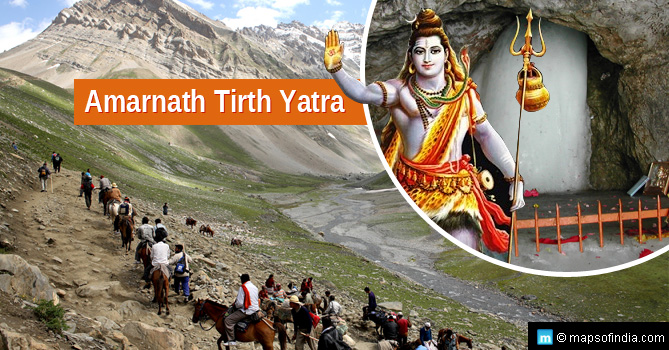The Amarnath yatra is India’s most popular pilgrimage trip. It is conducted for a fixed period of time in the summers and usually starts in the month of Shravan (July – August). Every year, thousands of pilgrims from across the country flock to this holy cave and shrine in the south Kashmir Himalayas. This year, the much awaited Yatra started on 29 June 2017, which also happened to be an auspicious day of Skandshasthi for Hindus and shall conclude on Shravan Purnima . The 45-day Yatra ends on 7 August 2017. Registration for the Amarnath Yatra for this year begins from 1 March 2017.
Lord Amarnath Cave and Shrine
Some 140 km from Srinagar, 46 km from Pahalgam and at an altitude of 3,888 metres above sea level, lies the most popular Hindu pilgrimage centre and the holiest shrine of the Hindus: the Amarnath Cave, which houses Lord Amarnath’s shrine. Surrounded with snowy mountains, the cave remains fully covered in snow almost throughout the year. It is open to the public only during the summers for a short time. Inside the cave, you find the shrine of Lord Shiva, in the form of a naturally created ice lingam. It is said that the lingam grows and shrinks with the moon cycle. There are two more Ice Lingams, near the main shrine, that of Maa Parvati and of their son, Lord Ganesha.
Read: Amarnath Cave Story
Amarnath Yatra Trip 2017
The 2017 Amarnath Yatra began on 29 June this year. However, entrance to the cave is highly regulated. A person has to register themselves first to undertake this pilgrimage tour. Registration for this year had started in March itself. It is done on ‘First-Come-First-Serve Basis’. The annual Amarnath Yatra is managed by Shri Amarnathji Shrine Board (SASB) which was constituted by the Jammu & Kashmir State Legislature Act in 2000.
The number of pilgrims entering the shrine is fixed on the basis of a pre-defined quota per day per route. Interested pilgrims can fill in and submit the online registration form on SASB’s website. The forms are also available in the branches of Punjab National Bank, Jammu and Kashmir Bank and Yes Bank. A system of ‘Group Registration’ was introduced by the SASB last year to facilitate registration of pilgrims wishing to travel in a group. The yatra is entirely managed by the SASB; it provides various services including power supply, telecommunication, firewood, food, medical camps etc.
How to Reach Amarnath?
- Air: The nearest airport is Srinagar. Helicopter services are also available
- Rail: The nearest Railway Station is Jammu.
- Road: Jammu and Srinagar are also connected through road.
There are two routes to reach the holy Amarnath cave. One is the ancient and traditional Pahalgam route. It takes five days to reach the cave through this route by trekking. The total distance from Pahalgam to the cave is 46 km. Another preferred route for trekking in recent years is the 14 km Baltal-Holy cave route. It takes one day to complete this trek. Though the trekking is short, it is steep. This route is less crowded as only those pilgrims who can walk are allowed and no ponies are allowed here. But the Pahalgam route, which is wider, is more crowded as it gives access to yatris who walk as well as those riding on ponies. This year, the Board has kept the maximum limit to only 7,500 pilgrims everyday on each route daily. This number does not include the pilgrims who would travel by helicopter.
Insurance by SASB
A pilgrim who is duly registered by the SASB for the yatra is issued a “Yatra Permit” and the person is entitled to an insurance cover of Rs.1 lakh.
Do’s and Dont’s for the Trek
- Keep yourself fit to undertake the yatra. You need to start preparing your body and mind one or two months before starting the journey. Go for regular walks and try to make your body flexible to enable it to undertake the arduous journey.
- You should do deep breathing exercises because as you climb higher and higher for the trek, the oxygen level goes down.
- All pilgrims have to obtain a compulsory health certificate (CHC) from doctors/hospitals listed by the states and UTs before applying for a yatra permit.
- For the trek, you should wear comfortable woollen clothes and jackets, along with proper shoes, to keep yourself covered properly from head to toe.
- Carry a small umbrella, raincoat, torch, gloves etc.
- Keep an ID card handy.
- Carry a water bottle and some dry snacks with you during the course of the journey.
- It is better to keep a moisturising lotion to protect your skin from the harsh cold winds.
- Take short rests in between while trekking. Don’t exert too much. Walk at a slow pace.
- Follow the instructions issued by the Administration.
- Carry some common medicines for immediate relief.
Don’ts
- It is advisable not to stop at places which have danger signs or at places where there are less number of people.
- Don’t take any kind of drugs during the journey.
- Do not take oily or fried food.
- It is advisable for aged people and children not to undertake the journey.
Read More:
Amarnath Yatra Map
Amarnath Yatra and Operation Shiva
Travel to Amarnath





